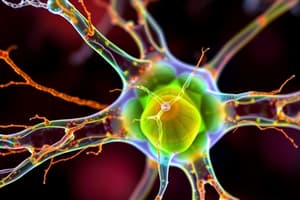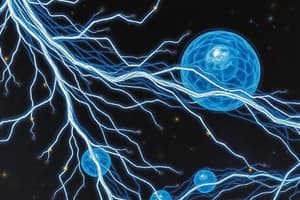Podcast
Questions and Answers
What is the primary function of cilia in unicellular organisms, and how do they differ from their function in non-motile cells?
What is the primary function of cilia in unicellular organisms, and how do they differ from their function in non-motile cells?
Cilia are used for cellular motility in unicellular organisms, whereas in non-motile cells, they are used to move extracellular materials and have a sensory function.
What is the main difference between cilia and flagella in terms of their motion and structure?
What is the main difference between cilia and flagella in terms of their motion and structure?
Cilia use a coordinated oar-like motion, whereas flagella exhibit a variety of patterns of motions, including asymmetrical waveforms and symmetrical propeller-like movements.
What is the role of the basal body in the structure of cilia and flagella?
What is the role of the basal body in the structure of cilia and flagella?
The basal body is an MTOC identical to the centriole and is responsible for forming the doublets of the axoneme.
What is the arrangement of microtubules in the axoneme, and what is the function of the radial spoke proteins?
What is the arrangement of microtubules in the axoneme, and what is the function of the radial spoke proteins?
What is the mechanism of intraflagellar transport, and how do kinesin and cytoplasmic dynein contribute to it?
What is the mechanism of intraflagellar transport, and how do kinesin and cytoplasmic dynein contribute to it?
What is the role of the dynein stem and nexin bridges in the movement of cilia and flagella?
What is the role of the dynein stem and nexin bridges in the movement of cilia and flagella?
What is the primary function of Microtubule-Organizing Centers (MTOCs) in cells?
What is the primary function of Microtubule-Organizing Centers (MTOCs) in cells?
What is the main component of the centrosome, and what is its role in microtubule formation?
What is the main component of the centrosome, and what is its role in microtubule formation?
What is the orientation of microtubules during assembly, and how does growth occur?
What is the orientation of microtubules during assembly, and how does growth occur?
What is the role of GTP in microtubule dynamics, and what happens to GDP-bound tubulin?
What is the role of GTP in microtubule dynamics, and what happens to GDP-bound tubulin?
What is dynamic instability, and what is the role of plus-end tracking proteins (+TIPs) in regulating microtubule dynamics?
What is dynamic instability, and what is the role of plus-end tracking proteins (+TIPs) in regulating microtubule dynamics?
What is the function of the ring of 13 γ-tubulin monomers in complex with additional proteins at the site of nucleation?
What is the function of the ring of 13 γ-tubulin monomers in complex with additional proteins at the site of nucleation?




